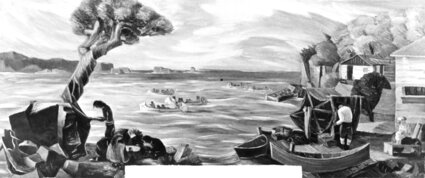Knot Pining: 1937 post office mural's fate is a mystery
February 2, 2024

Dewey Albinson's mural at the Cloquet Post office likely disappeared in the 1960s. This picture is from when it hung above the postmaster's office door there, the blank space indicating the door frame.
There was an interesting program on Minnesota Public Radio last week on the New Deal, the government efforts in the 1930s to pull the country out of the Great Depression. Included in the Jan. 24 Marketplace program was a segment on the Living New Deal project, an effort to locate and map across the country the many projects spurred by President Franklin Roosevelt's New Deal through the Works Progress Administration and other federal agencies.
One of those projects was the Cloquet Post Office, built in 1935 for $90,000. After opening, the Treasury Department's Section of Painting and Sculpture commissioned a mural to be painted in the lobby, one by a renowned Minnesota painter at the time, Dewey Albinson. One of the enduring legacies of the New Deal is that it was very inclusive, including those who work in the arts. There are thousands of New Deal era artist projects found across the country.
For those familiar with the post office, or those who visit the Living New Deal website, there is definitely something peculiar. There is no mural. It is listed as both "lost" and "destroyed" on online accounts of Albinson's work, called "Lake Superior Shores, Yesterday and Today."
Albinson, who was from Minneapolis, had a fondness for the North Shore. The mural installed in the Cloquet lobby depicted a bustling scene of life in Grand Portage, including the Spirit Tree, which has also been known as the Witch Tree.
"I made a mural of that tree showing the Indians putting tobacco on the tree representing Lake Superior yesterday and then today I show fishermen there, a fisherman with his nets and his family," Albinson said in an interview in 1965, six years before he died at age 73.
Albinson also did a mural for the post office in Marquette, Michigan, which still exists.
So what happened to the Cloquet work? Extensive remodeling of the post office, likely done after $176,000 was appropriated through the General Services Administration in 1965, probably led to its demise.
Rachael E. Martin, the former director of the Carlton County Historical Society, has articles on file there about the missing mural. Writing in The Senior Reporter, Martin describes the mural from a photo found in the National Archives. She also found records of the post office remodel in 1965 that showed that the wall that the mural had been hung on was removed to make more space in the lobby.
From there, the trail goes cold. We will follow up if Martin can offer any additions on her expert research.
Todd Manisto, a former postmaster in Cloquet, said the mural question has come up a few times. He, like Martin, has asked older postmasters about the mural and never resolved what might have happened to it. "No one can recall it," he said.
Could it have been moved? If so, where? The museum doesn't have it, and a 10-foot long mural would be hard to simply misplace.
There are at least 26 post office murals in Minnesota that were federally funded through the New Deal. All of them, save for the one in Cloquet, still exist, either still in a post office or moved to a museum.
"Many post office murals have vanished over the years," wrote museum specialist Patricia Raynor in 1997 for a Smithsonian newsletter.
Aside from the mystery it evoked here in Cloquet, the Living New Deal program was a fascinating one. To have a listen to the Jan. 24 broadcast, visit http://www.marketplace.org/2024/01/24/fdr-new-deal. To check out projects across the country and right here in our own backyard, visit livingnewdeal.org.
And if anyone can recall the mural that once graced the post office here, let us know by emailing [email protected] or by calling 218-216-6292.







